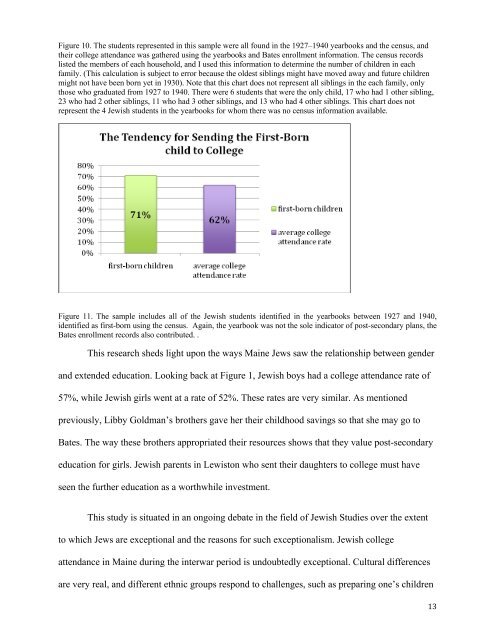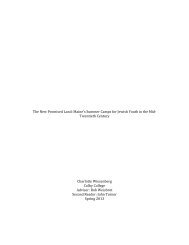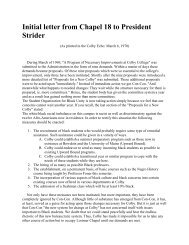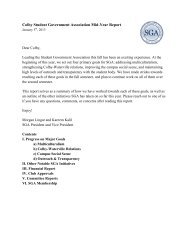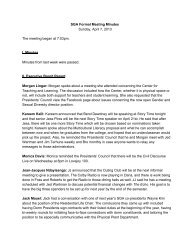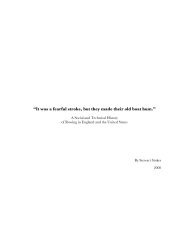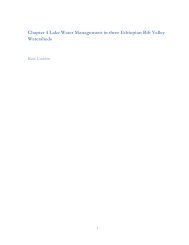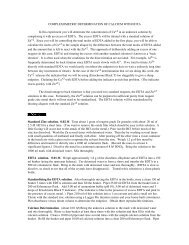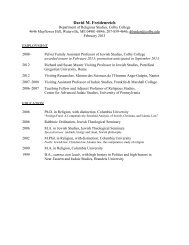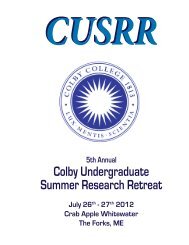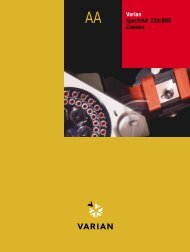College Attendance Among Jews in Lewiston, Maine, During the ...
College Attendance Among Jews in Lewiston, Maine, During the ...
College Attendance Among Jews in Lewiston, Maine, During the ...
Create successful ePaper yourself
Turn your PDF publications into a flip-book with our unique Google optimized e-Paper software.
Figure 10. The students represented <strong>in</strong> this sample were all found <strong>in</strong> <strong>the</strong> 1927–1940 yearbooks and <strong>the</strong> census, and<br />
<strong>the</strong>ir college attendance was ga<strong>the</strong>red us<strong>in</strong>g <strong>the</strong> yearbooks and Bates enrollment <strong>in</strong>formation. The census records<br />
listed <strong>the</strong> members of each household, and I used this <strong>in</strong>formation to determ<strong>in</strong>e <strong>the</strong> number of children <strong>in</strong> each<br />
family. (This calculation is subject to error because <strong>the</strong> oldest sibl<strong>in</strong>gs might have moved away and future children<br />
might not have been born yet <strong>in</strong> 1930). Note that this chart does not represent all sibl<strong>in</strong>gs <strong>in</strong> <strong>the</strong> each family, only<br />
those who graduated from 1927 to 1940. There were 6 students that were <strong>the</strong> only child, 17 who had 1 o<strong>the</strong>r sibl<strong>in</strong>g,<br />
23 who had 2 o<strong>the</strong>r sibl<strong>in</strong>gs, 11 who had 3 o<strong>the</strong>r sibl<strong>in</strong>gs, and 13 who had 4 o<strong>the</strong>r sibl<strong>in</strong>gs. This chart does not<br />
represent <strong>the</strong> 4 Jewish students <strong>in</strong> <strong>the</strong> yearbooks for whom <strong>the</strong>re was no census <strong>in</strong>formation available.<br />
Figure 11. The sample <strong>in</strong>cludes all of <strong>the</strong> Jewish students identified <strong>in</strong> <strong>the</strong> yearbooks between 1927 and 1940,<br />
identified as first-born us<strong>in</strong>g <strong>the</strong> census. Aga<strong>in</strong>, <strong>the</strong> yearbook was not <strong>the</strong> sole <strong>in</strong>dicator of post-secondary plans, <strong>the</strong><br />
Bates enrollment records also contributed. .<br />
This research sheds light upon <strong>the</strong> ways Ma<strong>in</strong>e <strong>Jews</strong> saw <strong>the</strong> relationship between gender<br />
and extended education. Look<strong>in</strong>g back at Figure 1, Jewish boys had a college attendance rate of<br />
57%, while Jewish girls went at a rate of 52%. These rates are very similar. As mentioned<br />
previously, Libby Goldman’s bro<strong>the</strong>rs gave her <strong>the</strong>ir childhood sav<strong>in</strong>gs so that she may go to<br />
Bates. The way <strong>the</strong>se bro<strong>the</strong>rs appropriated <strong>the</strong>ir resources shows that <strong>the</strong>y value post-secondary<br />
education for girls. Jewish parents <strong>in</strong> <strong>Lewiston</strong> who sent <strong>the</strong>ir daughters to college must have<br />
seen <strong>the</strong> fur<strong>the</strong>r education as a worthwhile <strong>in</strong>vestment.<br />
This study is situated <strong>in</strong> an ongo<strong>in</strong>g debate <strong>in</strong> <strong>the</strong> field of Jewish Studies over <strong>the</strong> extent<br />
to which <strong>Jews</strong> are exceptional and <strong>the</strong> reasons for such exceptionalism. Jewish college<br />
attendance <strong>in</strong> Ma<strong>in</strong>e dur<strong>in</strong>g <strong>the</strong> <strong>in</strong>terwar period is undoubtedly exceptional. Cultural differences<br />
are very real, and different ethnic groups respond to challenges, such as prepar<strong>in</strong>g one’s children<br />
13


